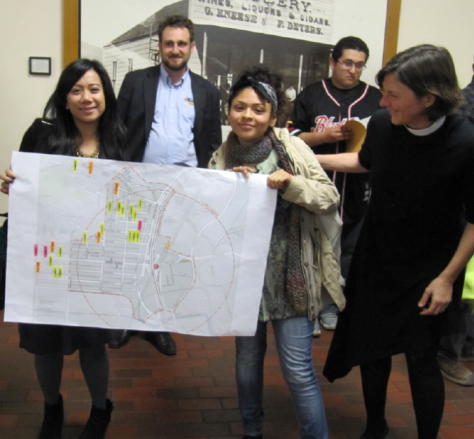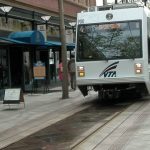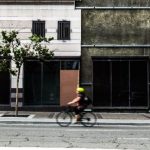Youth, community organizations, and housing coalitions come together to fight displacement in South San Francisco
By Clarrissa Cabansagan, TransForm
South San Francisco—known by locals as South City—has always housed a predominantly working class community. Its identity as an industrial city is rooted in historical ties to labor unions, even as it has evolved into a bedroom town for other regional job centers.
Today, South City residents hold fewer than 10% of the city’s jobs. Combined with rapidly increasing rents and home prices, the jobs-housing imbalance means that many longtime residents are not sure they’ll be able to stay. At the same time, the recent establishment of the biotech industry has brought a whole new workforce to South San Francisco, who could also benefit from a shift in the jobs-housing ratio.
The South San Francisco Downtown Station Area Plan presented an important opportunity to help keep South City residents in their communities, create new housing for biotech workers, and ensure future prosperity for the entire city. However, the plan had a long way to go to include meaningful anti-displacement policies and community benefits. The City Council was more focused on downtown beautification and revitalization than affordability.
So we got involved at the beginning of the planning process three years ago to ensure that the Plan would address the growing jobs-housing imbalance in South City. In the end, we achieved three of our four top policy goals; and along the way, we energized and engaged new voices in a part of the Bay Area where advocacy has not been a defining factor in government decisions.
Ensuring benefits for all residents in South City
With funding from the Great Communities Collaborative, TransForm joined with the San Mateo Union Community Alliance to lead a broad coalition of labor, housing, environmental, and transportation advocates in an effort to inject good labor standards, affordability, and anti-displacement policies into the Plan.
The coalition drafted a Community Benefits Platform that called for the Plan to benefit those most vulnerable to displacement, communities located in South City’s downtown. These communities are overwhelmingly lower-income households, Latino families (68%), renters (79%), families with children, and the city’s highest proportion of severely overcrowded households. With the help of UC Berkeley’s Center for Community Innovation, we determined that over 1,100 low-income renter households were at risk of rapid displacement in the Plan area.
The Community Benefits Platform also drew connections between many facets of what makes a community great. Our coalition helped lift up the message that an economically vibrant downtown hinged on a plan that addressed transportation, housing, labor, and open space, not just one or a few of these. And we helped people that were directly affected by these issues bring their voices to the decision-makers – though it wasn’t easy.
#4SouthCity brings new voices to the movement
The most significant challenge we encountered was getting low-income renters to meetings so they could share their perspectives. The reality is that these communities face real barriers to participating in City Council and Planning Commission meetings.

#4SouthCity and coalition member highlight downtown rents mapping.
When the draft Plan was released in July, new voices joined our coalition: youth from the local high school who live in Downtown South San Francisco began organizing as #4SouthCity. Their voices breathed life into the public process and changed the tenor of conversation around the plan.
In partnership with the San Mateo County Union Community Alliance and Housing Leadership Council, local students canvassed nearly 800 homes to survey downtown residents on their rent increases. At the final Plan adoption hearing, #4SouthCity youth leader, Alondra Aragon, presented the Council with a map of rent increases tagged throughout the Plan area. She testified about how her family and many others were facing recent rent increases that are unsustainable. Some rents had already increased by $200 a month, and many of these cases were whole families renting out individual bedrooms in single family homes to keep housing costs down.
Gustavo Lopez, a former South City resident and youth organizer, spoke about his own experience with the rising rents and actual displacement. He advocated for the Council to consider implementing policy that controlled rents in the downtown area. “We should have policies enacted that are going to keep people here,” he said. “Invest not just into big business, but invest into people. Invest into South City.” Their voices significantly changed the conversation around displacement just months before plan adoption, in a city where new housing units already command rents upwards of $2,500 a month.
Passing the plan, with more work to do
In late January, the City Council unanimously passed its Downtown Station Area Specific Plan centered on creating a more vibrant, walkable, bikable and transit-oriented environment around a currently obscured and inaccessible Caltrain station.
The plan reflects strong wins on three of the four goals in the South City Community Benefits Coalition platform. The plan:
- Provides for greenways, public plazas, and parks;
- Includes great parking policies to reduce vehicle trips, and excellent bike and pedestrian improvements with an emphasis to connect travelers from eastside employment centers and Grand Avenue to the Caltrain station; and
- Has strong language encouraging all developers to utilize local workers, apprentices from state certified apprenticeship programs, and to pay area standard wages.
- The Plan doubles the number of homes in the downtown by about 1,400 new housing units, and commercial square footage by about 1.2 million square feet for new office and research and development uses.
And so far, South City has come much further along in Plan implementation than we expected. The city has secured full funding for a redesign of the Caltrain station and expects to complete the improvements within five years. The city has also been awarded a parking technical assistance grant through the City/County Association of Governments of San Mateo County to encourage even more ridership at the Caltrain station. We’re delighted to see what is afoot in South City and proud to have catalyzed momentum on the Council to address needs for community stabilization.
However, the plan still offers little in the way of new affordable housing and does not directly address community member concerns about rising rents and displacement as a result of gentrification. While the Council did not make specific commitments in the draft plan, Mayor Rich Garbarino emphasized that the Council does not take these housing concerns lightly and that they would make sure to maintain continued dialogue on the issues of displacement and gentrification. Vice Mayor Mark Addiego went further to say, “We know what we are doing, we know the consequences…We haven’t figured out a way to solve the housing concern, nor has the state.” The City Council has instructed staff to work with residents so that decision-makers can begin to respond proactively.
One thing is certain. In South San Francisco, the fight against displacement is neither unique, nor over yet. Thanks to our collective efforts over the past three years, this community is ready to continue the struggle together.
The South San Francisco Coalition for Community Benefits was made possible through funding from the Great Communities Collaborative and the San Francisco Foundation. Thank you to all of our coalition partners, our community leaders, and their representatives:
#4South City
Friends of Caltrain
Greenbelt Alliance
Housing Leadership Council
San Mateo County Building Trades Council
San Mateo County Union Community Alliance
Sheetmetal Workers Union Local 104
Sierra Club Loma Prieta Chapter
Silicon Valley Bicycle Coalition
TransForm
UFCW Local 5





